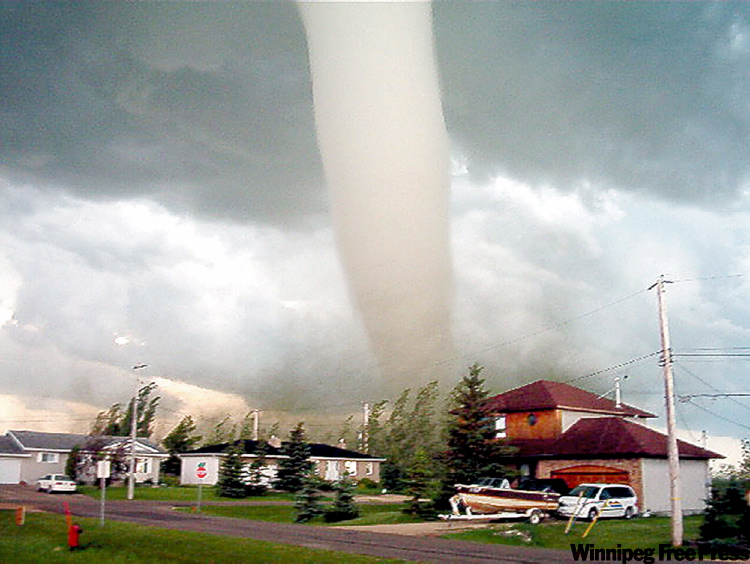Elie offers tornado lessons
Forecasters get heads-up in time for this year's twister season
Advertisement
Read this article for free:
or
Already have an account? Log in here »
To continue reading, please subscribe:
Monthly Digital Subscription
$0 for the first 4 weeks*
- Enjoy unlimited reading on winnipegfreepress.com
- Read the E-Edition, our digital replica newspaper
- Access News Break, our award-winning app
- Play interactive puzzles
*No charge for 4 weeks then price increases to the regular rate of $19.00 plus GST every four weeks. Offer available to new and qualified returning subscribers only. Cancel any time.
Monthly Digital Subscription
$4.75/week*
- Enjoy unlimited reading on winnipegfreepress.com
- Read the E-Edition, our digital replica newspaper
- Access News Break, our award-winning app
- Play interactive puzzles
*Billed as $19 plus GST every four weeks. Cancel any time.
To continue reading, please subscribe:
Add Free Press access to your Brandon Sun subscription for only an additional
$1 for the first 4 weeks*
*Your next subscription payment will increase by $1.00 and you will be charged $16.99 plus GST for four weeks. After four weeks, your payment will increase to $23.99 plus GST every four weeks.
Read unlimited articles for free today:
or
Already have an account? Log in here »
Hey there, time traveller!
This article was published 06/04/2010 (5711 days ago), so information in it may no longer be current.
Lessons learned from Canada’s strongest documented tornado in Elie, Man. three years ago — and research from like-sized twisters in the U.S. — should give forecasters here a head’s up in time for this year’s tornado season.
Tornado season extends from April to September with peak months in June and July, according to Enviroment Canada.
Wind shear is believed to have played a major role in the 2007 tornado at Elie and major twisters that have been studied in the U.S., said University of Manitoba associate professor John Hanesiak at the Centre for Earth Observation Science.

Wind shear, the change in wind speed and direction within a slight change in altitude, happens frequently in tornados.
But research is showing rapid changes in wind direction in the lower part of the atmosphere – which happened the day of the Elie tornado — may be a warning sign, said Hanesiak.
A paper in the Electronic Journal of Severe Storms Meteorology in the U.S. shows a "kink" separating speed shear from directional shear in the environments of some supercells producing significant tornadoes. The big ones tended to be characterized by angles near 90 degrees, whereas the "non-tornadic storms" were not.
A careful look at the the low-level "hodograph" — a graph showing the vertical pattern or profile of winds measured from a specific location during a certain time — in both time and space in relation to the storm motion can help to forecast supercell tornadoes, said Hanesiak.
The "F5" Elie tornado topped the Fujita severity scale. An F5 rating is for winds of 418 to 509 km/hr that cause tremendous damage to large structures and can tear off exterior walls and roofs. Tornadoes of this magnitude account for less than one per cent of all tornadoes, Environment Canada says. In Elie, the suppertime twister picked up houses and vehicles whole. It cut a swath 300 metres wide and 5.5 kilometres through the town about 40 kilometres west of Winnipeg.
Fortunately, no one was seriously injured.
"The Elie tornado event — spawned from a supercell storm — had this very strong low-level wind shear and the critical angle of 90 degrees as the paper outlined," said Hanesiak.
"We know this from the weather balloon data — the weather balloon was launched from downtown Winnipeg at the local weather office. Without this critical balloon data, we would be somewhat ‘guessing’ what the actual environment was like on this day," he said.
Hanesiak said he’s looking forward to a master’s thesis by one one of his students on the Elie tornado that has been delayed since the master’s student was hired by Environment Canada out of the province.
In the meantime, a "change of season" workshop is held every spring with university researchers and Environment Canada meteorologists sharing information, said Hanesiak. Tornado and wind shear research from the U.S. that gibes with the Elie experience will be on the radar at the workshop the first week in May, he said.
"The forecasters at the Winnipeg weather office launch weather balloons every day at 1 p.m. …We can use that information…It gives some indication of how likely a storm might be (a tornado) if it does form."
carol.sanders@freepress.mb.ca

Carol Sanders
Legislature reporter
Carol Sanders is a reporter at the Free Press legislature bureau. The former general assignment reporter and copy editor joined the paper in 1997. Read more about Carol.
Every piece of reporting Carol produces is reviewed by an editing team before it is posted online or published in print — part of the Free Press‘s tradition, since 1872, of producing reliable independent journalism. Read more about Free Press’s history and mandate, and learn how our newsroom operates.
Our newsroom depends on a growing audience of readers to power our journalism. If you are not a paid reader, please consider becoming a subscriber.
Our newsroom depends on its audience of readers to power our journalism. Thank you for your support.

